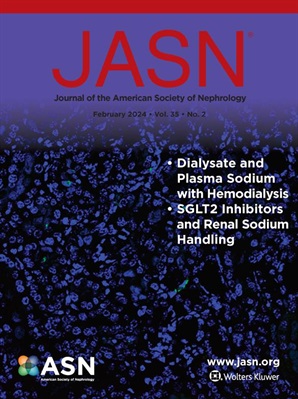血液透析患者循环菌群特征和心血管死亡率。
IF 9.4
1区 医学
Q1 UROLOGY & NEPHROLOGY
引用次数: 0
摘要
背景:循环微生物群的改变最近被认为与心脏代谢疾病的发病机制有关。然而,证据主要是基于细菌DNA特征,而循环真菌DNA特征(真菌群)的特征和作用仍然未知。方法在一项960名血液透析患者的全国前瞻性队列研究中,我们使用内部转录间隔段(ITS)核糖体DNA (rDNA)测序来表征基线血清样本中循环无细胞真菌群的特征,并使用校正潜在混杂因素的Cox模型来研究它们与全因死亡率和心血管死亡率的关系。循环菌群特征对已知过早死亡风险因素的预测能力以及炎症对其与死亡率关联的中介作用也进行了研究。结果本组患者平均年龄为60±13岁,男性占53%,糖尿病患者占57%,血液透析时间中位数(四分位数间隔[IQI])为3.1(1.5,5.8)年。经过严格的质量控制,在80%的患者中检测到ITS rDNA。经rDNA分类分析,共鉴定出397个真菌分类群,包括7门149科241属。在中位(IQI)随访2.2年(1.7年,2.4年)期间,205例和75例患者分别经历了全因死亡和心血管死亡。虽然循环菌群特征与全因死亡率无关,但较高的α多样性(调整HR [95% CI], 1.64[1.14-2.39]每高1单位)和特定属的存在(分别为3.79[2.20,6.51],2.72[1.44,5.12]和2.21[1.28,3.81])与较高的心血管死亡率显著相关,没有炎症的显著中介作用。将这些属添加到已知危险因素的模型中可以改善心血管死亡率预测。结论:血液透析患者的循环菌群特征与心血管死亡率相关,强调了它们作为预后生物标志物的潜力,并需要进一步的机制研究。本文章由计算机程序翻译,如有差异,请以英文原文为准。
Circulating Mycobiota Signatures and Cardiovascular Mortality among Patients Undergoing Hemodialysis.
BACKGROUND
Alterations of the circulating microbiota have recently been implicated in the pathogenesis of cardiometabolic disease. However, the evidence is based primarily on bacterial DNA signatures, while the characteristics and roles of circulating fungal DNA signatures (mycobiota) remain unknown.
METHODS
In a nationwide prospective cohort of 960 hemodialysis patients, we characterized circulating cell-free mycobiota signatures in baseline serum samples using internal transcribed spacer (ITS) ribosomal DNA (rDNA) sequencing and examined their associations with all-cause and cardiovascular mortality using Cox models with adjustment for potential confounders. The added predictive ability of circulating mycobiota signatures over known risk factors for premature mortality and the mediation effect of inflammation on their association with mortality were also examined.
RESULTS
In this cohort, the mean patient age was 60±13 years, 53% of patients were male, 57% had diabetes mellitus, and the median (interquartile interval [IQI]) hemodialysis vintage was 3.1 (1.5, 5.8) years. After stringent quality controls, ITS rDNA was detected in 80% of these patients. Taxonomic analysis of the detected rDNA demonstrated a total of 397 fungal taxa, including 7 phyla, 149 families, and 241 genera. During a median (IQI) follow-up of 2.2 (1.7, 2.4) years, 205 and 75 patients experienced all-cause and cardiovascular death, respectively. While circulating mycobiota signatures were not associated with all-cause mortality, higher α diversity (adjusted HR [95% CI], 1.64 [1.14-2.39] per 1 unit higher) and the presence of specific genera (3.79 [2.20, 6.51], 2.72 [1.44, 5.12], and 2.21 [1.28, 3.81] for Wallemia, Cladosporium, and Fusarium, respectively) were significantly associated with higher cardiovascular mortality, without a significant mediation effect of inflammation. Adding these genera to models with known risk factors improved cardiovascular mortality prediction.
CONCLUSIONS
Circulating mycobiota signatures were associated with cardiovascular mortality in hemodialysis patients, highlighting their potential as prognostic biomarkers and warranting further mechanistic investigation.
求助全文
通过发布文献求助,成功后即可免费获取论文全文。
去求助
来源期刊
CiteScore
22.40
自引率
2.90%
发文量
492
审稿时长
3-8 weeks
期刊介绍:
The Journal of the American Society of Nephrology (JASN) stands as the preeminent kidney journal globally, offering an exceptional synthesis of cutting-edge basic research, clinical epidemiology, meta-analysis, and relevant editorial content. Representing a comprehensive resource, JASN encompasses clinical research, editorials distilling key findings, perspectives, and timely reviews.
Editorials are skillfully crafted to elucidate the essential insights of the parent article, while JASN actively encourages the submission of Letters to the Editor discussing recently published articles. The reviews featured in JASN are consistently erudite and comprehensive, providing thorough coverage of respective fields. Since its inception in July 1990, JASN has been a monthly publication.
JASN publishes original research reports and editorial content across a spectrum of basic and clinical science relevant to the broad discipline of nephrology. Topics covered include renal cell biology, developmental biology of the kidney, genetics of kidney disease, cell and transport physiology, hemodynamics and vascular regulation, mechanisms of blood pressure regulation, renal immunology, kidney pathology, pathophysiology of kidney diseases, nephrolithiasis, clinical nephrology (including dialysis and transplantation), and hypertension. Furthermore, articles addressing healthcare policy and care delivery issues relevant to nephrology are warmly welcomed.

 求助内容:
求助内容: 应助结果提醒方式:
应助结果提醒方式:


